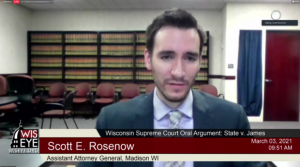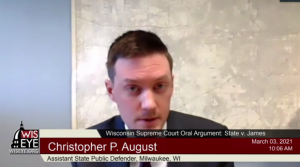Court considers arguments over reasonable suspicion in vehicle search
By: Michaela Paukner, [email protected]//March 3, 2021//
Court considers arguments over reasonable suspicion in vehicle search
By: Michaela Paukner, [email protected]//March 3, 2021//
The Wisconsin Supreme Court is considering whether an appellate court conducted a proper reasonable suspicion analysis in a case centered on a traffic stop that resulted in a gun charge.
The court heard oral arguments in State v. James T. Genous on Wednesday. In 2016, Genous was arrested and charged with one count of being a felon in possession of a gun after a search of his car.
The arresting officer testified that he saw Genous parked in front of a West Allis residence around 3:30 a.m. Genous turned off his car’s headlights, a woman got in the car for about 15 to 20 seconds and then she got out. The officer said he couldn’t see what was going on inside the vehicle and didn’t see the woman carrying anything when she got out. Genous then turned his lights back on and drove away.
The officer said he thought the woman was a known heroin user who had previous interactions with the police, and he believed a drug deal was happening. He followed Genous’ car for three blocks and didn’t observe any traffic violations. He also didn’t come up with anything when he ran the license plates.
The officer stopped Genous and questioned him about the interaction. Two other officers arrived during that time, and one said he noticed a gun in plain view inside the car. No drugs were found, and the officer said Genous was cooperative.
Genous filed a motion to suppress the evidence from the traffic stop, arguing it was obtained as a result of an illegal seizure. He said there was no reasonable suspicion to stop his car because all that the police observed was his interaction with the woman.
The trial court denied the suppression motion, finding that the officers had a reasonable suspicion to stop Genous under the totality of the circumstances. Genous then pleaded guilty to the charge and was sentenced to one year of initial confinement and one year of extended supervision.
Upon appeal, Genous again argued that police lacked reasonable suspicion to believe he was making a drug deal or engaged in other criminal activity. He said none of the facts, individually or cumulatively, was sufficient to constitute a reasonable suspicion that criminal activity was taking place.
The Court of Appeals agreed, finding that the police placed heavy emphasis on Genous’ interaction with the woman and the location of the stop, which was considered a high drug-trafficking area, as the basis for the stop. The court said it was unable to discern the required reasonable suspicion necessary to justify the investigative stop.

The state asked the Wisconsin Supreme Court to review the case, claiming that the appellate court failed to properly account for various factors in its reasonable suspicion analysis. Scott E. Rosenow, assistant attorney general, said the most important facts pointing to reasonable suspicion were the early morning hours and short duration of the woman’s interaction with Genous, the woman’s reputation as a known heroin user and the neighborhood’s reputation as a high drug-trafficking area.
“Each suspicious fact is a building block, and eventually when you put them all together, you’re building something that whole is greater than a sum of individual parts,” Rosenow said. “If the court does that in this case, I really don’t see how it would not find legal suspicion under these facts.”
Christopher P. August, the assistant state public defender representing Genous, said if the State is using a building a wall as the metaphor, the court needs to assess how well-crafted the structure is by assessing each individual factor before looking at the evidence together.

Justice Rebecca Bradley said she struggled with August’s approach of looking at each factor in isolation, rather than taking them in totality under the Fourth Amendment.
“That seems to completely reverse what the U.S. Supreme Court has instructed us is the proper approach in Fourth-Amendment analyses,” Bradley said.
August argued that the court needed to look at the factors in context to determine if the officer made the decision to stop Genous on a hunch or a reasonable suspicion.
“The State is trying to bootstrap its weak evidence that was elicited in the trial court with some of these generic assumptions and problematic contextual considerations,” August said.
He suggested that the court set forth rules and guidelines for lower courts when considering the high-crime area criterion. The guidelines should offer objective proof to justify labeling an area as high crime, August said.
Justice Brian Hagedorn said it seemed like August was asking the court to impose evidentiary requirements to govern trial court findings of fact, rather than letting the parties to argue through litigation.
“If, as a justice system, we are serious about addressing disparities and unequal treatment in our justice system, I think that the high-crime area criterion is one target that the court could address,” August said.
In his rebuttal, Rosenow called the debate over labeling an area as high crime a red herring in this case. He said West Allis police labeled it as a high drug-trafficking area, rather than simply high crime.
“That’s important because he stopped Genous on suspicion of drug dealing,” Rosenow said. “There is a linkage between the two — the reputation of the area and the activity that the officer observed.” Follow @WLJReporter
Legal News
- State Bar leaders remain deeply divided over special purpose trust
- Former Wisconsin college chancellor fired over porn career is fighting to keep his faculty post
- Pecker says he pledged to be Trump campaign’s ‘eyes and ears’ during 2016 race
- A conservative quest to limit diversity programs gains momentum in states
- Wisconsin prison inmate pleads not guilty to killing cellmate
- Waukesha man sentenced to 30 years for Sex Trafficking
- 12-year-old shot in Milwaukee Wednesday with ‘serious injuries’
- Milwaukee man convicted of laundering proceeds of business email compromise fraud schemes
- Giuliani, Meadows among 18 indicted in Arizona fake electors case
- Some State Bar diversity participants walk away from program
- Wisconsin court issues arrest warrant ‘in error’ for Minocqua Brewing owner
- Iranian nationals charged cyber campaign targeting U.S. Companies
WLJ People
- Power 30 Personal Injury Attorneys – Russell Nicolet
- Power 30 Personal Injury Attorneys – Benjamin Nicolet
- Power 30 Personal Injury Attorneys – Dustin T. Woehl
- Power 30 Personal Injury Attorneys – Katherine Metzger
- Power 30 Personal Injury Attorneys – Joseph Ryan
- Power 30 Personal Injury Attorneys – James M. Ryan
- Power 30 Personal Injury Attorneys – Dana Wachs
- Power 30 Personal Injury Attorneys – Mark L. Thomsen
- Power 30 Personal Injury Attorneys – Matthew Lein
- Power 30 Personal Injury Attorneys – Jeffrey A. Pitman
- Power 30 Personal Injury Attorneys – William Pemberton
- Power 30 Personal Injury Attorneys – Howard S. Sicula











